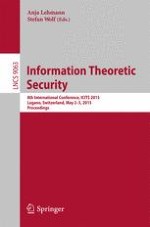2015 | Buch
Information Theoretic Security
8th International Conference, ICITS 2015, Lugano, Switzerland, May 2-5, 2015. Proceedings
herausgegeben von: Anja Lehmann, Stefan Wolf
Verlag: Springer International Publishing
Buchreihe : Lecture Notes in Computer Science
